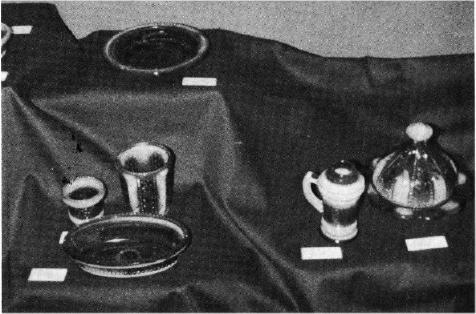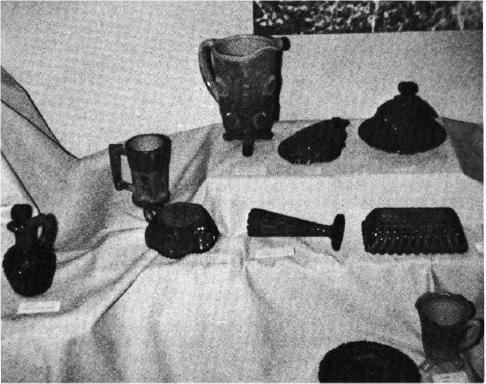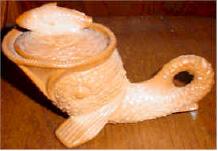National Depression Glass Association
Preserving America's Glass Manufacturing Heritage
Greentown Glass
by Betsy Brown
Glass Review - August 1979
Beauty lies in the eyes of the beholder, and certainly all who are lucky enough to behold a piece of Greentown glass will agree that it is truly beautiful and unusual glassware.
 HOLLY AMBER - the color was called Golden Agate |
|---|
Greentown Glass is a term placed on all glassware made by the Indiana Tumbler and Goblet Co. from 1894 to 1903. Greentown, Indiana, was a rural town without any industry, and its citizens eagerly jumped at the chance to have a glass factory erected in their town. Greentown was a profitable place at the time for the factory because there was an abundant supply of water and natural gas upon drilling, and also the tract of land that was offered for the factory was right alongside of the Cloverleaf Railroad which would take and ship the glassware north and east to markets.
The I.T.& G. Co. began production on June 11, 1894, and for the next three years only jelly jars, tumblers, goblets, and bar goods were produced and usually in clear and amberina colors. In 1897 a larger furnace and an addition to the factory allowed many new items and colors to be produced.
The board of directors for this flourishing company were: Thomas Jenkins, David Jenkins, Lewis Jenkins, Charles Miller, and D. C. Jenkins. Seems it was pretty much a family affair!
Acting as chief designer for the I.T.& G. Co. was Charles Miller, Jr., who stayed there until 1897 when he left to seek gold. He was then replaced by Charles E. Beam.
 Assorted CHOCOLATE glass pieces |
|---|
The glass formula chemist was Jacob Rosenthal. He was a man who should have rightly deserved the title of "Most Creative" when it came to the beautiful and unique colors that he created, such as chocolate, nile green, and golden agate, these being the most sought after colors by Greentown collectors today.
Jules Braun was hired as the factory's western salesman. His job was to bring pieces of the I.T.&G. Co's fine glassware to prospective merchants. Jules Braun also represented the factory's glassware when it was exhibited at the Glass and Crockery Show held at the Monongahela House Hotel in Pittsburgh, Pennsylvania.
Men women, and children were employed at this factory. It was an equal opportunity employer when it came down to the part of HARD WORK! The women worked in the packing room filling barrels, the men operated the machinery and were also gatherers. The children were helpers to the men and they were to receive half of the wages of the man they helped, which were 50¢ per day.
In November of 1899, the Indiana Tumbler and Goblet Co. merged with a combine called the National Glass Co. This combine was made up of a total of 19 factories, after the I.T.& G. Co. joined.
Glassware made by the Indiana Tumbler and Goblet Co. was quite
inexpensive, but even more so, the colors, the wide assortment of
pieces and the designs made their glassware in constant demand by the
public. One type of item that the public especially liked were the
 I.T.& G. Co.'s novelty items, many of which were based upon the
representation of animals such as a hen on a basket, and the most
famous piece of Greentown Glass, the dolphin (at right). Me thinks I hear you
saying "big deal," but ah ... he is a very special dolphin, for how
many dolphins do you know that have scales?
I.T.& G. Co.'s novelty items, many of which were based upon the
representation of animals such as a hen on a basket, and the most
famous piece of Greentown Glass, the dolphin (at right). Me thinks I hear you
saying "big deal," but ah ... he is a very special dolphin, for how
many dolphins do you know that have scales?
Saturday. June 13, 1903 marked the factory's last day of production. A fire raged through the entire factory almost totally destroying it. Left jobless were 3O0 workers. At the time of the blaze the estimated loss of both stock and the factory itself was $150,000. It is not certain why the fire occurred. Some say it was arson by the company itself because of Greentown's failing natural gas supply. Others say it was started by the explosion of niter in the packing room. Another assumption as to the cause of the fire on which the I.T.&G. based a court case was that a Cloverleaf locomotive threw up a spark, which then began the blaze. The I.T.& G. Co. tried to sue the rail road for lack of spark arrestors on their locomotives but lost the case; thus the factory was never rebuilt.
A Lowell, Michigan, resident, the late Dr. Ruth Herrick, is credited with making Greentown Glass as popular as it is today. Every weekend she drove down to Greentown to dig for fragments of glass at the site of what was once the Indiana Tumbler and Goblet Co., and these pieces helped her to put a book together.
In 1970 a Greentown Glass Museum was opened in Greentown, and since then, the second weekend in June hosts the annual Greentown Glass Festival. It is a three day event which includes a carnival, Indiana's largest parade, an antique show, and a special meeting and a dinner for NGGA members.
When Ruth Herrick died, her extensive collection of Greentown Glass was willed to three museums, one being the Grand Rapids, Michigan, Public Museum. This museum also acquired the printing rights to her book Greentown Glass. At the present time the Grand Rapids Public Museum has a lovely display of Dr. Herrick's Greentown Glass and they are currently revising her book which will be printed in late July.